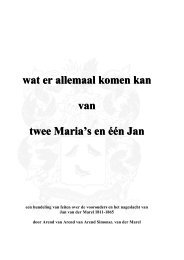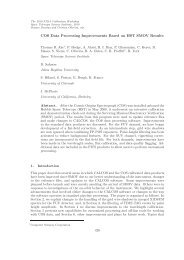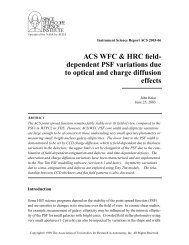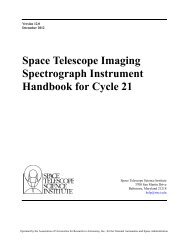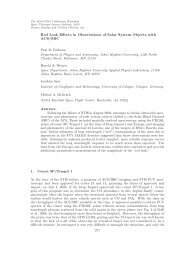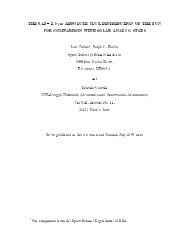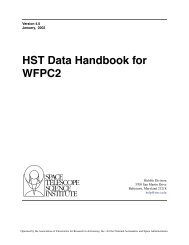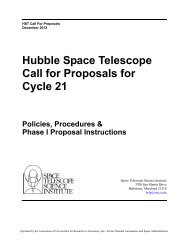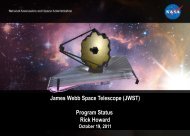STScI Annual Report 2002: A Living Mission
STScI Annual Report 2002: A Living Mission
STScI Annual Report 2002: A Living Mission
Create successful ePaper yourself
Turn your PDF publications into a flip-book with our unique Google optimized e-Paper software.
20 science essays<br />
The Lessons of Deuterium<br />
One way for astronomers to ‘observe’ astrophysical<br />
processes is to study isotopes, which are nuclear variations<br />
of an element with the same number of protons but<br />
differing numbers of neutrons. Isotopic abundances can<br />
reveal the special conditions and processes that created<br />
or destroyed the nuclei of atoms in the Big Bang, inside<br />
stars, by cosmic ray collisions, and in other astrophysical<br />
environments. Using high-resolution spectroscopy, such<br />
as with Hubble’s former Goddard High Resolution<br />
Spectrograph (GHRS) or current Space Telescope Imaging<br />
Spectrograph (STIS) or the Far Ultraviolet Spectroscopic<br />
Explorer (FUSE), astronomers can observe signature spectral<br />
lines of isotopes located in interstellar or intergalactic<br />
space; then, they can use models of spectral line formation<br />
to derive abundances. In this way, we have developed<br />
an understanding of the original creation of light elements<br />
in the Big Bang and of the synthesis of heavy elements<br />
inside stars.<br />
Although hundreds of isotopes surround us today,<br />
only seven nuclear variations of four light elements<br />
survived the Big Bang in significant quantities: 1 H, 4 He, 2 H<br />
(deuterium, D), 3 He, 7 Li, 7 Be, and 6 Li. (Standard nomenclature<br />
identifies an isotope by a preceding superscript to<br />
the element’s chemical symbol giving the ‘mass number’<br />
or total count of nucleons—protons and neutrons.) No<br />
heavier elements survived because no isotope with mass<br />
number 5 or 8 is stable, which created a bottleneck for the<br />
reactions underway during the Big Bang. Only later, after<br />
the first stars formed out of the original isotopes, were the<br />
heavier elements (metals) created by nucleosynthesis in<br />
the new and necessary temperature and pressure conditions<br />
of the stellar interior. Mass loss from mature stars<br />
has continuously enriched space with metals since that<br />
time, giving rise to later generations of stars, planets, and<br />
life itself.<br />
Deuterium is simple and special, and its cosmological<br />
story is unique. It is a fragile nucleus, consisting of a<br />
proton and a neutron, and has a small binding energy,<br />
which means that it is easily destroyed inside stars.<br />
Because we believe it has no significant source other<br />
than the Big Bang itself, the abundance of deuterium<br />
should decrease steadily everywhere over the age of<br />
the universe, as matter is processed through stars.<br />
Scott D. Friedman<br />
Among the seven original isotopes, deuterium is first<br />
in importance as a probe of the Big Bang. This is due both<br />
to its simple evolutionary path of steady disappearance<br />
since its formation and to its special diagnostic value.<br />
While the primordial abundance of any of the light original<br />
isotopes provides constraints for important cosmological<br />
parameters, deuterium is the most sensitive of all.<br />
Measuring the primordial value of D/H—the ratio of the<br />
deuterium to hydrogen abundance—is the best way to<br />
estimate the baryon-to-photon ratio in the early universe<br />
and, from it, to determine Ω B, the fraction of the critical<br />
density contributed by baryons. The critical density—a<br />
benchmark of cosmology—is the dividing line between<br />
an open (forever expanding) and closed (eventually<br />
contracting) universe.<br />
Astronomers detect H and D by observing Lymanseries<br />
absorption lines caused by interstellar or intergalactic<br />
atoms along sight lines toward background light sources,<br />
either stars or quasars. At rest wavelengths, these lines<br />
occur in the far ultraviolet portion of the spectrum, from<br />
1216 Å (Lyman α) to 912 Å (Lyman limit). The deuterium<br />
lines are slightly shifted towards shorter wavelengths, by<br />
82 km s -1 or 0.33 Å at Lyman α. For sight lines without<br />
excessively complicated component structure, the D and H<br />
lines can be measured separately, yielding the D/H ratio.<br />
Since the same stellar processes that destroy deuterium<br />
also manufacture metals, which are scattered through the<br />
interstellar medium (ISM) by stellar explosions and winds,<br />
astronomers expect to find an anticorrelation between the<br />
D/H ratio and metallicity, usually measured as the ratio of<br />
the oxygen or silicon to hydrogen abundance. Observation<br />
of such an anticorrelation would provide strong support<br />
for our ideas of the source of deuterium and general<br />
principles of galactic chemical evolution.<br />
The first measurements of D/H in the ISM were made<br />
with the Copernicus satellite in the 1970s. The best of<br />
these sampled sight lines toward targets out to a distance<br />
of about 200 pc. The data hinted at the possibility of spatial<br />
variability in D/H, but they were also consistent with the<br />
single value of D/H = 1.5 x 10 -5 .<br />
GHRS made the most accurate ISM measurement,<br />
D/H = (1.46 ± 0.05) x 10 -5 , observing the cool star HR1099,<br />
36 pc away. Hubble measurements toward other targets,<br />
all closer than 80 pc, gave similar results. Since Hubble’s<br />
short wavelength limit is about 1150 Å, the only transition<br />
of the H and D lines available is Lyman α. This limits<br />
Hubble deuterium measurements to relatively short sight<br />
lines with modest H column densities, in order that the



